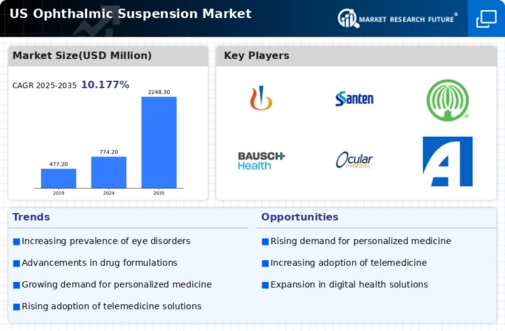Rising Healthcare Expenditure
The ophthalmic suspension market is poised for growth due to the rising healthcare expenditure in the US. Increased spending on healthcare services and pharmaceuticals is facilitating the development and availability of advanced ophthalmic products. In 2025, healthcare spending in the US is projected to reach approximately $4 trillion, with a significant portion allocated to eye care. This financial commitment is likely to enhance research and development efforts, leading to the introduction of novel ophthalmic suspensions that address unmet medical needs. As healthcare providers invest in better treatment options, the ophthalmic suspension market is expected to expand, driven by the demand for innovative therapies that improve patient outcomes.
Increasing Demand for Targeted Therapies
The ophthalmic suspension market is experiencing a notable increase in demand for targeted therapies aimed at specific eye conditions. This trend is driven by the growing prevalence of chronic eye diseases, such as glaucoma and age-related macular degeneration, which require precise treatment modalities. In the US, the market for targeted therapies is projected to reach approximately $3 billion by 2026, reflecting a compound annual growth rate (CAGR) of around 8%. The shift towards personalized medicine is influencing the development of ophthalmic suspensions that can deliver active ingredients directly to the affected areas, thereby enhancing therapeutic efficacy. As healthcare providers and patients alike seek more effective treatment options, the ophthalmic suspension market is likely to expand significantly, catering to the evolving needs of the population.
Aging Population and Eye Health Awareness
The demographic shift towards an aging population in the US is significantly impacting the ophthalmic suspension market. As individuals age, the incidence of eye disorders tends to increase, leading to a higher demand for effective treatment options. According to recent statistics, nearly 50% of individuals aged 65 and older experience some form of vision impairment. This growing awareness of eye health among older adults is prompting increased consultations with healthcare professionals, thereby driving the demand for ophthalmic suspensions. Furthermore, educational campaigns aimed at promoting regular eye examinations are likely to contribute to market growth. The ophthalmic suspension market is expected to benefit from this trend, as more patients seek innovative solutions to manage their eye health.
Advancements in Manufacturing Technologies
Technological advancements in manufacturing processes are playing a crucial role in shaping the ophthalmic suspension market. Innovations such as nanotechnology and improved formulation techniques are enabling the production of more effective and stable ophthalmic suspensions. These advancements not only enhance the bioavailability of active ingredients but also improve patient compliance by reducing the frequency of administration. As manufacturers adopt these cutting-edge technologies, the ophthalmic suspension market is likely to witness a surge in product offerings that meet the evolving needs of healthcare providers and patients. The ability to produce high-quality ophthalmic suspensions efficiently may also lead to competitive pricing, further stimulating market growth.
Growing Focus on Patient-Centric Solutions
The ophthalmic suspension market is increasingly influenced by a growing focus on patient-centric solutions. Healthcare providers are recognizing the importance of tailoring treatments to individual patient needs, which is driving the development of customized ophthalmic suspensions. This trend is particularly relevant in the context of chronic eye conditions, where personalized treatment regimens can lead to better patient outcomes. Additionally, the rise of digital health technologies is facilitating patient engagement and adherence to treatment plans. As patients become more involved in their healthcare decisions, the demand for ophthalmic suspensions that align with their preferences is likely to increase. This shift towards patient-centricity is expected to foster innovation and growth within the ophthalmic suspension market.





















Leave a Comment